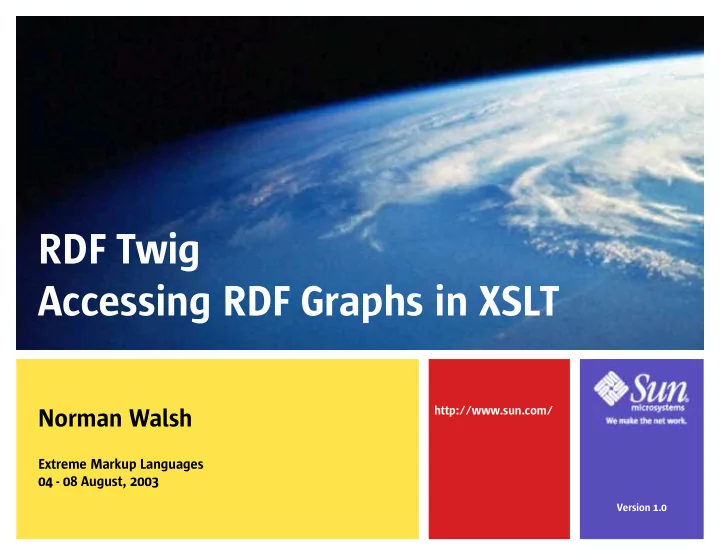

RDF Twig Accessing RDF Graphs in XSLT Norman Walsh http://www.sun.com/ Extreme Markup Languages 04 - 08 August, 2003 Version 1.0
Introduction “There's nothing as practical as a good theory” http://www.sun.com/ 2 / 29
Introduction “There's nothing as practical as a good theory.” “There's nothing as theoretical as good practice.” http://www.sun.com/ 3 / 29
Introduction “There's nothing as practical as a good theory.” “There's nothing as theoretical as good practice.” “Sometimes a practical solution is good enough.” http://www.sun.com/ 4 / 29
Observations • RDF is a useful way to store and process information that fits into the RDF paradigm. • Lots of information does fit into that paradigm. • RDF can be serialized in XML. • XSLT is a useful way to process XML. But... • Processing RDF with XSLT is difficult and tedious. http://www.sun.com/ 5 / 29
The Problem • XSLT (and XPath) are designed to operate on XML documents. XML documents are trees. • A collection of RDF statements is a directed graph, but it is not generally a tree. • Templates designed to transform RDF often stumble over this missmatch at the data model level. • But RDF has an XML serialization, doesn't it? http://www.sun.com/ 6 / 29
What about RDF Serialization? • Nodes in a tree have only one parent. • Nodes in a graph may have several “parents”. • If node identity is to be preserved: • Nodes must be treated in two different ways. • It boils down to: instantiate once. • Reference elsewhere. http://www.sun.com/ 7 / 29
Serialization Example Consider this small graph: And how it might be serialized: <A> <B> <C> ??? What do you do about A? http://www.sun.com/ 8 / 29
Serialization Example (Continued) <A node="n1"> <B node="n2"> <C node="n3"> <A node="n1"/> <E node="n4"> ... • Graph: B/C/A/* = B • Tree: B/C/A/* = empty node set http://www.sun.com/ 9 / 29
Working With Serialized RDF • Know your serialization tool. There are several flavors and recent RDF changes introduce at least one more. • Use keys and conditional logic in your templates to identify and correctly process nodes that are inline and nodes that are referenced. • In the general case, you need a choose statement for each node, one to test for @rdf:resource and one to test for @rdf:about . Difficult and tedious. http://www.sun.com/ 10 / 29
There's More Than One Way To Do It There's no single, right way to do the serialization. • Any node could be the “root” of the tree. • Nodes must be instantiated exactly once. • Which nodes are “new” and which are “duplicates” depends on where you start and how you build the tree. http://www.sun.com/ 11 / 29
RDF Twig • Let's you start at any node in the RDF graph. • Builds a serialized representation of that part of the graph (with a few user-tuneable parameters). • Returns the tree as a document so that you can apply XSLT to it. In short, RDF Twig lets you serialize interesting parts of the graph on the fly. http://www.sun.com/ 12 / 29
RDF Twig Implementation • RDF Twig is implemented as a set of (Java) XSLT extension functions and elements. • The current implementation is built on top of the Jena RDF toolkit. http://www.sun.com/ 13 / 29
How to Serialize Consider this graph: How can this be serialized (starting at A)? http://www.sun.com/ 14 / 29
Serialize Breadth First http://www.sun.com/ 15 / 29
Serialize Depth First http://www.sun.com/ 16 / 29
Serialize Breadth First Deep http://www.sun.com/ 17 / 29
Serialize a Leaf http://www.sun.com/ 18 / 29
RDF Twig Terminology twig A shallow breadth-first tree. dftwig A shallow depth-first tree. branch A deep tree. leaf A “tree” with no instantiated children. http://www.sun.com/ 19 / 29
RDF Twig in Action Load the model: <xsl:variable name="model" select="rt:load('diagrams/bgraph.rdf')"/> Grab a node: <xsl:variable name="A" select="rt:resource('http://uri/for/A')"/> Turn the results into a tree: <xsl:variable name="tree" select="rt:twig($A)"/> http://www.sun.com/ 20 / 29
RDF Twig in Action (Continued) At this point, $tree contains an XML document that can be queried and transformed with XSLT like any other input docu- ment.
RDF Twig in Action Construct a property: <xsl:variable name="label" select="rt:property('http://example.com/graph#', 'label')"/> Find some nodes: <xsl:variable name="findResults" select="rt:find($label, 'D')"/> Turn the results into a tree: <xsl:variable name="tree" select="rt:twig($findResults)/twig:result"/> http://www.sun.com/ 22 / 29
RDF Twig Functions • load() (and store() ) RDF graphs. • resource() gets (or creates) a single resource. • property() gets (or creates) a property. • twig() , dftwig() , branch() , leaf() get parts of a graph. http://www.sun.com/ 23 / 29
RDF Twig Functions (Continued) • find() finds resources (that have a property). • get() finds resources (that are a property). • filter() , filterNot() trim a set of resources. • union() , intersection() , difference() perform the obvious boolean operations on sets of resources. http://www.sun.com/ 24 / 29
RDQL Support RDF Twig now supports RDQL: <xsl:variable name="a"> <rq:rdql return="a"> SELECT ?a, ?b WHERE (?a, <http://somewhere/pred1>, ?b) AND ?b < 5 </rq:rdql> </xsl:variable> This is a result tree, so you need a node-set extension to ac- cess it. http://www.sun.com/ 25 / 29
Isn't There a Better Way? Wouldn't it be better to extend XPath (XSLT?) to operate over graphs? Yes, probably. But RDF Twig satisfies an immediate need: to access RDF graphs in XSLT stylesheets today. http://www.sun.com/ 26 / 29
A “Real” Example <xsl:variable name="contactType" select="rt:resource('http://nwalsh.com/rdf/palm#Contact')"/> <xsl:variable name="allContacts" select="rt:twig(rt:find($rdf:type, $contactType),1)/twig:result"/> ... <xsl:for-each select="$allContacts"> <xsl:apply-templates select="rt:leaf(string(@rdf:about))" mode="Contact"/> </xsl:for-each> http://www.sun.com/ 27 / 29
Warts • Deep trees can be prohibitively large. • “Serialize on the fly” is conceptually different. • Trying to build trees that are “just big enough” sometimes introduces the inline/reference problem again. • Function dispatch oddness in the current implementation. http://www.sun.com/ 28 / 29
References • RDF Twig: http://rdftwig.sourceforge.net/ • Saxon: http://saxon.sourceforge.net/ • Xalan Java: http://xml.apache.org/xalan-j/ • Jena: http://www.hpl.hp.com/semweb/jena http://www.sun.com/ 29 / 29
Recommend
More recommend